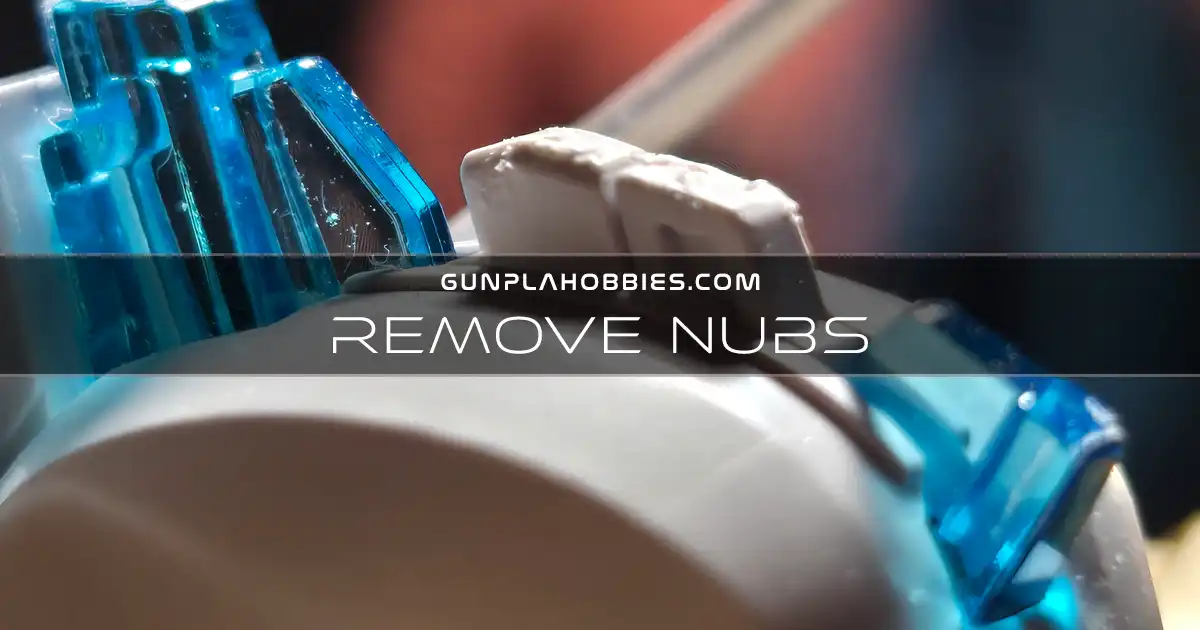Techniques to Remove Nubs from Gunpla Kits

Building Gunpla is a fun and rewarding hobby, but one challenge all builders face is removing nubs—the small plastic remnants left behind after cutting parts from the runner. Proper nub removal is crucial for achieving clean, professional-looking builds. In this guide, we’ll cover the best techniques for nub removal and highlight the preferred methods used by the Gunpla community.
Basic Tools for Nub Removal
Before we dive into techniques, let’s go over the essential tools you’ll need:
- Single-Bladed Nippers (e.g., GodHand, DSPIAE, or Tamiya) – Provide a cleaner, smoother cut than standard nippers.
- Standard Double-Bladed Nippers – Good for initial rough cuts before refining.
- Hobby Knife (X-Acto or OLFA) – Helps to scrape off remaining nub marks.
- Sanding Sticks and Files – Used to smooth out plastic surfaces.
- Glass File (Gunprimer Raser, Infini, or DSPIAE) – Gives a polished finish with minimal effort.
- Gundam Markers or Paint – Can be used to cover stress marks left by nubs.
Techniques for Nub Removal
1. Two-Cut Method (Most Common & Beginner-Friendly)
The two-cut method is the most beginner-friendly way to remove nubs while minimizing plastic stress. Instead of cutting directly at the base of the part (which can cause white stress marks or even break delicate pieces), this technique gradually removes the nub in two steps.
Steps:
- First Cut – Use nippers to cut away from the part, leaving about 2-3mm of plastic attached. This prevents stress from transferring to the part itself.
- Second Cut – Trim the remaining nub closer to the part carefully to prevent stress marks. Use light pressure and avoid squeezing too hard with the nippers.
✅ Pros: Simple, prevents plastic stress.
❌ Cons: May still leave a small nub that needs further refinement.
This technique is quick, easy, and effective for most builders, making it the go-to method for beginners and casual Gunpla fans.
2. Knife Scraping (For Smooth Finishes)
For builders who want an extra clean finish, using a hobby knife after cutting the nubs can refine the surface even further. This method is particularly useful for hard-to-reach areas and small nubs that stick out after nipper cuts.
Steps:
- After the two-cut method, use a hobby knife at a low angle to gently scrape the remaining nub.
- Apply light, controlled strokes to shave off excess plastic without cutting into the part itself.
✅ Pros: Quick and effective for small nubs.
❌ Cons: Requires steady hands to avoid cutting too deep.
This method is preferred by intermediate and advanced builders who want a precise, polished look without relying on sanding.
3. Sanding (For a Seamless Finish)
Sanding is the best way to eliminate any remaining imperfections, making it ideal for builders who want perfectly smooth plastic surfaces. Unlike knife scraping, which removes material by cutting, sanding gradually smooths the surface for a flawless finish.
Steps:
- After trimming nubs, start with a medium-grit sanding stick (400-600) to remove most of the excess plastic.
- Use higher grits (800-1000+) to smooth out the area without leaving visible scratches.
- For the best results, rub in one direction first, then switch to circular motions for a smooth blend.
✅ Pros: Best for completely removing nubs without visible marks.
❌ Cons: Takes more time and can change part shape if overdone.
Sanding is highly recommended for builders who plan to paint their kits, as it helps create an even surface that holds paint better.
4. Glass File Method (Community Favorite for Clean Finishes)
One of the newer and most preferred techniques in the Gunpla community is using glass files to remove nubs. Glass files work differently from traditional sanding by polishing the surface rather than grinding it down, leaving an ultra-smooth finish with minimal effort.
Steps:
- Use a glass file (e.g., Gunprimer Raser) to gently rub over the nub with light pressure.
- The file will gradually remove the plastic while leaving a polished, glossy surface that matches the surrounding plastic.
✅ Pros: Fast, effective, almost no risk of damaging parts.
❌ Cons: Expensive compared to regular sandpaper.
Many builders swear by glass files because they require little effort, work without damaging the part, and don’t leave scratches like traditional sanding.
Wet Sanding Method
For serious builders and painters, wet sanding is the best way to ensure a flawless finish. This technique reduces friction and prevents deep scratches, making it perfect for removing nubs on painted or glossy surfaces.
Steps:
- Use 1000+ grit sandpaper and dampen it with water to reduce heat and scratches.
- Gently sand in circular motions to even out the surface without scuffing the part.
- Wipe off excess water and let the part dry before moving on to the next step.
✅ Pros: Best for painted kits, leaves a flawless surface.
❌ Cons: Requires extra care to avoid over-sanding.
This technique is highly recommended for custom builders who apply topcoats, metallic paints, or high-gloss finishes.
Community Preferences
The Gunpla community has different preferences based on skill level and build type:
| Method | Preferred By | Reason |
|---|---|---|
| Two-Cut Method | Beginners & Speed Builders | Quick, easy, and safe |
| Knife Scraping | Experienced Builders | Precise control over nub removal |
| Sanding Sticks | Detail-Oriented Builders | Ensures a perfectly smooth surface |
| Glass File | Community Favorite | Fastest way to get clean nubs |
| Wet Sanding | Pro Painters | Ideal for seamless painted finishes |
For snap builders, the glass file method is highly recommended since it removes nubs without excessive effort. For painted kits, wet sanding ensures a professional finish.
Final Tips for Nub Removal
- Avoid cutting too close to the part initially – This prevents plastic stress marks.
- Work in good lighting – Helps to spot remaining nubs easily.
- Use a light touch when sanding – Too much force can reshape the part.
- Try different methods to see what works best – Everyone’s style is different!
With the right techniques, nub removal becomes a satisfying part of Gunpla building, leading to clean, professional-looking models. Whether you’re a beginner or an expert, taking time on nub removal makes a huge difference in the final result.
Happy building!

